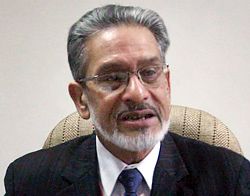'Only the coming years will tell whether the government finds this an easy way of relieving itself from its fiscal constraints.'

Dr Pronab Sen, former chairman, Indian Statistical Commission and former secretary, ministry of statistics and programme implementation, tells Prsanna D Zore/Rediff.com why he thinks the Reserve Bank of India did the right thing by transferring Rs 1.76 lakh crore to the Government of India and why it does not impinge on the RBI's autonomy.
How do you look at the RBI's decision to transfer Rs 1.76 lakh crore to the Government of India?
There are three parts to it as it appears now. One part is the transfer of a part of the capital reserves of the RBI, which the Bimal Jalan Committee has recommended. This was pretty much on the cards and I think it's a perfectly legitimate transfer.
The second is the transfer of the larger amount from the RBI's profits as dividend (Rs 1.23 lakh crore out of the total transfer of Rs 1.76 lakh crore) to the government. There are two components to it.
One is the dividend being paid on the old accounting basis, under which the gains from foreign exchange savings used to be the difference between the sale from foreign exchange and the previous week's price.
On that basis, the profits would have not been Rs 1.2 lakh crore, but would have been closer to about Rs 90,000 crore.
And then you have the third component where there is now an accounting change and the profit is counted as the current sales price of foreign exchange minus the weighted average of the historic costs of acquiring that foreign exchange.
Now, this has created a fairly large gap, and it amounts to somewhere between Rs 25,000 crore and Rs 30,000 crore.
Now, with Bimal Jalan (Committee) saying that the RBI is holding too much buffer that can be transferred, that's fine.
The regular dividend payment (by the RBI to the government), which has always happened, is also fine. It is this additional component (accruing to the government on account of the change in formula as explained by Dr Sen above), which is an issue. Because what it means, in effect, is that every time RBI sells foreign exchange, the government gets a bonanza.
And, this is potentially worrisome.
Why should this be worrisome?
Because the government might actually tell the RBI (to sell more foreign exchange to earn more rupees and transfer the same to the government). What happens otherwise is either the RBI can buy foreign exchange to create new money, or it can buy government bonds.
Until last year, the RBI was essentially buying foreign exchange and most of the money creation in India was through this mechanism.
Last year, what happened was most of the money creation came from the RBI by buying up government bonds and selling foreign exchange. So, that has two advantages for the government.
One is that the sale of government bonds become less influenced by the market demand because the RBI is buying those bonds. It's almost like monetisation.
And the second is that when RBI sells the foreign exchange, the government gets additional dividends.
This may actually lead to pressure on the RBI to sell dollars and buy government bonds. That in itself is worth an issue; that decision should be left to the RBI.
But if the government pressurises RBI (to sell dollars and buy government bonds), then it's an issue.
Should the RBI have done it given that then governor Dr Urjit Patel and then deputy governor Dr Viral Acharya had had fallout with the government on this issue and there was a lot of friction between them and the government?
Why was there so much opposition from these two to this transfer and in that context should the RBI have done it?
On this issue my sympathies are with the government because thr RBI essentially speaking is an agency of the government.
What the RBI was doing was making profits on the issuance of rupees and this is not the property of the RBI but of the State. These profits rightfully belong to the State.
Now, the RBI has to keep a part of it as reserve stock for various contingencies.
However, the RBI was determining, how much it should keep and how much it could give to the government without there being any guidelines or norms having been defined for this purpose.
So, in the opinion of the Bimal Jalan Committee, they (the RBI) were holding onto money that rightfully belongs to the government.
This money is made (by the RBI) from the power to print rupees, which is called Seigniorage. Now, the power to print currency belongs to the State, which is backing it.
If this were so simple, why would Dr Urjit Patel and Dr Viral Acharya have had friction with the government over the transfer?
They were talking about the independence of the RBI.
Doesn't this imply that the government was pressurising the RBI to do something that was not financially prudent?
That is not so clear, because they really didn't make it clear as to why they thought the independence of the RBI (could get jeopardised by the transfer of money from the RBI's reserves to the government).
The only hint we got was from Dr Viral Acharya's October 2018 speech where he used the word 'independence' for more than 44 times.
Yes, but he never elaborated (upon) what was the independence that was being taken away. Now, the fact of the matter is that think of the RBI as a company, a profit-making entity.
So, in a company, it is the shareholders who determine how much revenue should be paid and how much should be retained. The shareholder in this case is the government. So, that doesn't necessarily impinge on the independence or autonomy of the RBI.
Where it would impinge (on the autonomy of the RBI) is the part that I talked about if the government asks the RBI to behave in a particular way which goes against the RBI's own judgment as to what is good for the macro economy.

Can we say that, the government had no confidence in its resource-raising capabilities through other policy measures and so they dipped into the RBI's reserves, an unprecedented measure some say, to rescue itself from a tenuous fiscal situation?
That may be true up to a point, but that's a question of timing, it (the transfer of Rs 1.76 lakh crore from the RBI to the government) is not a question of principal.
Would you be worried about Dr Acharya's prognosis of 'kiss of death' for India's central bank and the 'market wrath' that is likely to follow?
Do you think the market will perceive this move negatively, and by market I mean the stock and the bond markets, as they believe that the government is resorting to desperate measures to shore up its revenue?
The question is whether you interpret this as a desperate measure. Or is it something that should have happened earlier.
Now, we've had three committees -- V Subrahmanyam (1997), Usha Thorat (2004) and Y H Malegam (2013) -- which have gone into the issue of what are the adequate reserves with the RBI should hold. So, whenever you put a number or the formula, for the appropriate reserves of the RBI, then anything in excess of that should be transferred to government.
This should have happened earlier, but the decision was taken (now). (So) It has happened now.
Talking about this 5.5% to 6.5% of total reserves that the Bimal Jalan committee recommended, and of which the RBI board decided to go with lower bound of 5.5% as contingency risk buffer, is it adequate to ring fence the Indian economy in case of a 2008-like financial meltdown? Or if there were to be a run on the Indian rupee and sudden flight of dollars?
You see, the thing is that the RBI is not alone in this. We've had crises before. So, what happened (then; during the financial meltdown of 2008) is the government stepped in. So, you had the market stabilisation bonds, which the government issued.
In a crisis, it is not only the business of the RBI, but it is the RBI and the government working in tandem. And that's the right way to go. To put the entire burden (of ring fencing the Indian economy) on the RBI will not be fair.
Can this 5.5% to 6.5% range set by the Bimal Jalan Committee be breached by this government or any future governments in case they face a revenue shortfall for some reason?
That is the danger (that it might happen). Again, this will have to go back to the RBI Board. Whether the 5.5% to 6.5% range is appropriate or not, I'm not able to comment because I have not done the algebra. The Bimal Jalan Committee has gone into this arithmetic and I have no reason to question it. The question is whether it (the setting up of the lower bound) should have been at 5.5%, 6% or 6.5%.
I would have felt been comfortable if they (the RBI Board) had gone with something above the 5.5% lower bound.
Former RBI deputy governor and the vice chairman of the Bimal Jalan Committee, Dr Rakesh Mohan told me he would have been comfortable with the lower bound at 6%.
I too would have felt more comfortable (if the RBI board) had gone with that as the lower bound.
In this context, has this transfer set a good or bad precedent?
This should not have happened now. I mean, this (transfer and its mechanism) should have been inbuilt in the RBI Act.
Whether this has set a good or bad precedent, only the coming years will tell whether the government finds this (mechanism) as an easy way of relieving itself from its fiscal constraints.
Photograph: Francis Mascarenhas/Reuters.










